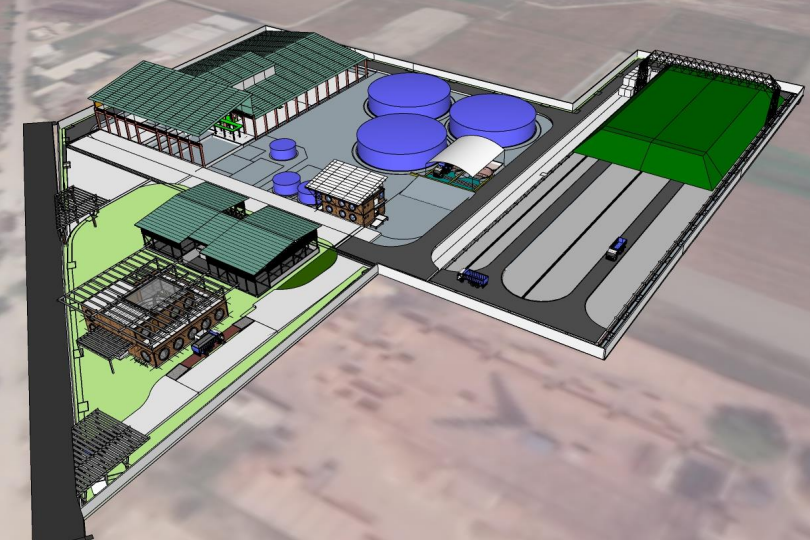NZ-first bioenergy plant one step closer


Similar technology has been established in India on a much larger scale (modelled above) with input from Haarman Madon who has since brought his own patented technology to New Zealand. Photo: Alimentary Systems.
A bioenergy plant soon to be built in Nelson Tasman is hoped to eventually unlock the ability to reduce New Zealand’s total emissions by 5 per cent and save the country upwards of $1 billion.
The project will be the end of multiple years of work by Alimentary Systems to get to this point.
“Nelson takes our patent from lab to pilot,” says co-founder Matthew Jackson.
“The purpose of the project is to show that we can do zero waste, zero liquid discharge and zero emissions, and reduce ratepayers’ costs.”
The Bioenergy Resource Recovery Plant (BRRP, pronounced ‘burp’) is hoped to be commissioned on Bell Island, adjacent to the wastewater treatment plant, by mid-2026.
The BRRP is a circular system that combines the carbon in organic waste and the nitrogen in wastewater sludge to create methane gas and a synthetic fertiliser replacement.
The methane is then used to power the plant, with the fertiliser and any remaining gas then able to be sold for a profit.
“We’re trying to figure out a way where the system can extract so much value that we can change the behaviour,” Matthew says.
He adds that the technology has been proven overseas and the Bell Island project is hoped to validate the methodology in a New Zealand context to unlock benefits for the entire country.
Regional benefits of the technology include delaying the need to build costly new landfills by diverting significant amounts of organic waste and sludge into the BRRP facilities.
In Nelson Tasman, a new landfill is currently budgeted to cost $42 million, though the existing landfill sites in the region have another 80 years of capacity at the current rate of waste collection.
Organic waste also decomposes in landfills, releasing methane into the air, and significantly contributes to regional emissions.
About 59 per cent of Tasman District Council’s emissions come from landfill, though landfill emissions from Nelson Tasman’s York Valley Landfill are captured or flared.
Diverting organic waste into BRRP facilities would remove new methane sources from landfills. Nationally, councils send 9000 tonnes of organic waste to landfills each day, and industry generates 363,000 tonnes of organic waste that must be managed in line with strict environmental standards.
If this waste is diverted to BRRP facilities, Matthew says New Zealand’s total emissions would decrease by 5 per cent annually.
The fertiliser by-product could then be sold to horticulturalists to decrease the country’s reliance on imported fertilisers.
“This is about how do we maximize the value of the organic waste stream to capture the energy, capture the nutrients, and then put them back into the system so that they can be utilized again.”
However, the project’s benefits aren’t solely environmental and could bring massive financial benefits.
New Zealand is currently on track to overshoot its 2030 climate emissions target by 114 million tonnes of carbon dioxide equivalent.
The cost of purchasing the offshore carbon credits required to offset that shortfall is expected to be about $3-24 billion, depending on the future price of carbon credits on the international market.
At the lower end of the Treasury’s estimates, each tonne of emissions would cost a minimum of $26.32. However, Matthew says that Alimentary System’s technology could lower that price significantly to as $15.07.
Given New Zealand’s shortfall of 114 million tonnes of carbon dioxide equivalent, the savings could amount to $11.25 tonnes of carbon dioxide equivalent, or at least $1.28 billion by 2030.

Locals might also save a few extra dollars too. The average Tasman resident with a rubbish bag service uses one and a half rubbish bags per week.
If residents participated in a collection service that diverted their kitchen waste away from their general rubbish and into a BRRP facility, coming down to just one rubbish bag per week, they could save about $125 a year in bag costs, even with the cost of a council-run collection service factored in.
The BRRP project on Bell Island has secured a three-year license from the Nelson Regional Sewerage Business Unit (NRSBU) to take sludge from the island’s wastewater treatment plant.
General manager Nathan Clarke confirmed that the NRSBU had agreed to a non-exclusive licence to occupy a small part of Bell Island adjacent to the wastewater treatment plant. The plant will provide the BRRP with small volume of untreated sludge so Alimentary Systems can carry out its trial over the next three years.
“We were open to giving them access to the land as their goals around reusing resources like wastewater sludge are the same as ours,” Nathan says.
“It can be hard to find land that is suitably zoned and located so we were happy to help them out as the results of the trial will be useful for the industry as a whole.”
All the sludge from the Bell Island plant is converted into biosolids, “an excellent fertiliser” which are beneficially re-used.
Alimentary Systems has applied for a grant from the Ministry for the Environment’s Waste Minimisation Fund for up to $3.7 million. The result of their application is expected by July.
If granted, the funding will go towards the $8 million cost of setting up the BRRP with the remaining cost being covered by private impact investors.
“Our ultimate aim… is to have zero emissions to the environment,” Matthew says.
Alimentary Systems has applied for a grant from the Ministry for the Environment’s Waste Minimisation Fund for up to $3.7 million. The result of their application is expected by July.
If granted, the funding will go towards the $8 million cost of setting up the BRRP with the remaining cost being covered by private impact investors.
“Our ultimate aim… is to have zero emissions to the environment,” Matthew says.

